Celestron Omni XLT 150 Review
by Joe Bergeron
by Joe Bergeron
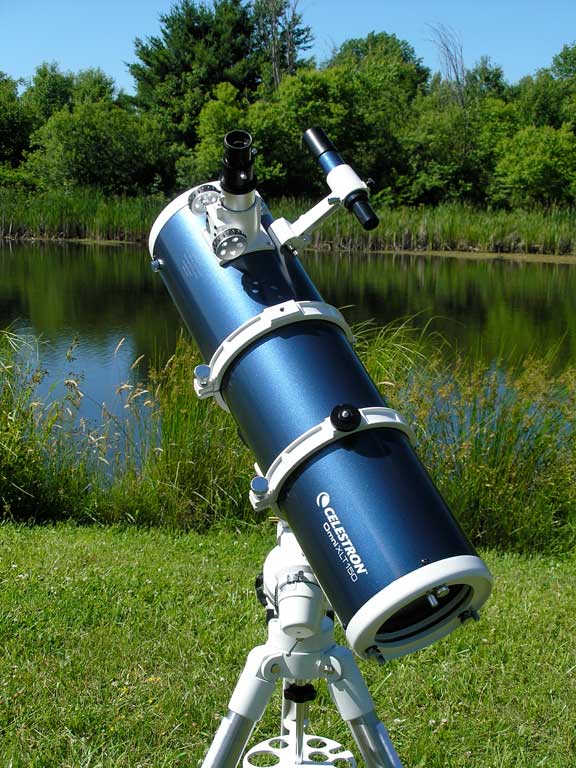
Celestron’s
line
of low-cost Chinese import telescopes, the Omni XLT, has
intrigued me since its introduction. The reason is simple,
if slightly ridiculous: the colors. The deep-blue-and-white
color combination is very appealing to me (obviously). In
June 2007 I noticed that Oklahoma astronomy dealer
Astronomics had a slightly used example of one of the
cheapest models, the $400 Omni XLT 150 reflector, available
for a total of $338. According to them, their customer had
returned it in favor of something smaller. Since it’s easy
to blow more money than that on a single eyepiece, I decided
to satisfy both my curiosity and my liking for blue
telescopes and white mounts by ordering it.
The scope arrived
promptly in two boxes of substantial size. Both were double
boxed, which was good, since they had suffered at the hands
of FedEx. The inner boxes and their contents were in perfect
condition. The larger and heavier of the two boxes contained
the mount and tripod, which are identical for each of the
four Omni XLT models (the others being a 102mm f/10
refractor, a 120mm f/8 refractor, and a 127mm SCT). The
other box, considerably lighter in weight, contained the
optical tube, rings, dovetail bar, and accessories.
Everything was packed well and sensibly, and all parts were
present.
Since I am a wizened
scholar of telescopes and their ways, nothing in those boxes
was a mystery to me. I quickly assembled the telescope
without referring to the manual. For those needing it, the
documentation is comprehensive, well-written, and useful.
Also included is a basic version of “The Sky” planetarium
software, if you happen to use Windows and have nothing
better already.
The assembled telescope
is very handsome. The tube color is blueberry, slightly
metallic and sparkly. The mount and tube fittings are
finished in a thick, glossy, snow-white paint. I was not
disappointed with this aspect of the telescope.
The main tube is made of
thin, rolled steel with a prominent seam opposite the finder
mount. It's out of round along this seam, being a bit
flattened there. This is apparent when the scope is mounted
in the rings. The tube color is very efficient at heating up
in sunlight. The tube interior has a nice flat black
coating. The entire optical tube assembly shows considerable
thought and expertise in its design and execution. The 150
is f/5. With its 150mm (5.9”) aperture and 750mm focal
length, the tube is a short 27 inches in length. The optics
arrived in a state of pristine cleanliness. The primary
mirror has a neat center ring to assist in collimation. Both
mirrors have Celestron’s XLT multi-layer reflective coating,
which should produce the brightest images possible for a
reflector of this aperture. Popping in a Cheshire eyepiece
revealed the scope to be out of collimation. Since it was
easy to look through the Cheshire and reach the collimation
knobs at the same time, I was able to align it in a few
seconds. The collimation knobs were a bit difficult to turn,
and might defeat a child. The rear cell also has locking
screws to assist in holding collimation. Some sort of
membrane covers the back of the mirror, presumably to
prevent dust from migrating into the tube.
The diagonal mirror
appeared to be properly placed and aligned, according to my
sight tube. This mirror is glued onto a four-vane spider
which appears to be well designed. The vanes are very thin.
Collimation requires the use of an Allen wrench in three
small screws. The 1.25-inch focuser is pretty good.
Initially, racking it in and out produced an alarming
crunching sound, which I believe was caused by a bit of
Styrofoam packing material caught in the rack. The large
knobs, with their rubber gripping surfaces, are
TeleVue-esque in appearance. Eyepieces are secured with two
set screws. This arrangement looks and feels cheap after
years of using only brass compression ring fittings, but as
I have observed so many times, one cannot have everything.
The little 30mm finder
is mounted on a tall stalk and uses two-point alignment with
a third spring-loaded point of contact. The finder has good
eye relief and a focusing objective, and appears to be quite
decent if you can make do with a small straight-through
finder. I replaced it with a 50mm RACI finder to make
finding things easier and more comfortable.
The main telescope’s
plastic dust cap has a 40mm off-axis pull-out aperture, for
those times when you want to project the sun’s image onto a
card, or when you want to guess at what Galileo might have
seen with his tiny telescopes (your view will be much better
than his though).
One small issue was that
one of the tube mounting rings was slightly rotated on the
dovetail bar, meaning it was angled on the tube. Attempting
to loosen the bolt which attached the ring to the bar was a
challenge. Synta appears to hire one of those gigantic
Chinese basketball players to tighten these bolts. It would
not budge, and my Herculean (by way of Napoleon Dynamite)
efforts eventually sheared the bolt. I replaced it and was
able to correct the issue.
The CG-4 equatorial head
is a cute little handful, a functional miniature version of
a German equatorial mount. It would be perfect for a smaller
telescope, but I suspected it would prove marginal with the
150, or with any of the Omni XLT scopes except the stubby
little 5” SCT. This is a matter of small concern to me, for
reasons which I’ll reveal later. The head is well designed
and constructed. It has provision for a polar alignment
scope which is not included. The little setting circles are
primarily decorative. The right ascension circle is loosely
mounted. The manual knobs provided for the slow motion
controls are actually decent, big and mounted on metal
stalks.
The stainless steel
tubular tripod, with its 1.75” diameter legs, should be fine
with any of the Omni XLT scopes, and looks especially
imposing with the dinky CG-4 head mounted atop it. Since I
tower above the landscape at 6’2”, the scope’s height on
this tripod works well for me, but in some positions it
would be inaccessibly tall for a child.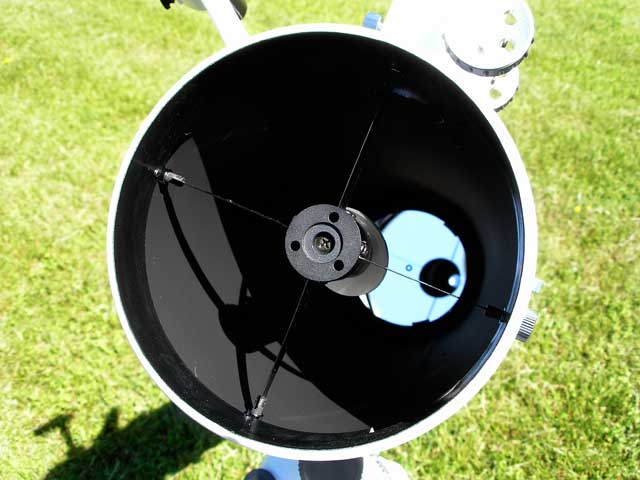

Finally, the scope comes
with a generic 25mm eyepiece with a 50 degree apparent field
of view. It seems pretty sophisticated for what is
essentially a freebie eyepiece, with good eye relief and a
screw-up eye guard for adjusting it. With this scope it
delivers 30X and a field of 1.6 degrees. With a 5mm
exit pupil, this is as low a power as I would wish to use on
this scope.
The telescope makes a
good first impression as it stands gleaming in the sunlight.
First light took place on a night of the full moon, which
was somewhat limiting. I will add that this scope looks
beautiful in the light of a full moon. The blue of the tube
is visible, and the white parts appear luminous.
My first impression of
the mount was correct: marginal for a scope of this size.
Slight touches and adjustments produced vibrations lasting a
few seconds, the exact time depending on the attitude of the
scope. However, the scope remained usable at powers up to
214X. It moved smoothly and freely, and the manual slow
motions were also smooth. I did not find it too difficult to
overlook the shakiness of the mount, and I am not inclined
to be overly forgiving about such things.
Focusing on stars
revealed an unfortunate, needless drawback of the scope’s
design. The focuser is tall, which is inappropriate for a
small, fast reflector. The constricted light path and the
large distance between the eyepiece and the diagonal mirror
result in vignetting. If the eyepiece focused at a point
closer to the diagonal, field illumination would be
improved. As it is, full illumination is barely achieved
only in the very center of the field, if at all. This kind
of design is all too common in commercial telescopes. There
is no real reason for it. The telescope tube should be a
couple of inches longer, and the focuser a couple of inches
shorter, to avoid this issue. I suppose the tall focuser
with its long travel is used to maximize the scope’s
compatibility with various accessories. It does this at the
expense of optimal visual performance. How much difference
this actually makes at the eyepiece is hard to determine,
but I suspect the effect is minimal.
Despite this, the scope
produced some pleasant views, though bright star images at
high power were nowhere near as clean as they are with my
refractors. Fainter stars cleaned up better. At 214X,
Epsilon Lyrae was resolved into four decent Airy disks
surrounded by fairly neat diffraction rings. At 107x, M13
presented a powdering of faint stars despite the
illumination of the full moon. Using a 22mm Panoptic
eyepiece, I saw sharp stars occupying the central 80% of the
field, typical for an f/5 reflector.
I devoted most of my
time to studying Jupiter at 214x. Jupiter, with its mass of
low-contrast detail, is a critical test of any telescope.
Any scope which cannot perform well on this planet is of
little interest to me. That night’s seeing was mostly good,
with an occasional flicker of a moon or shifting of the
disk. The planet’s edge was usually sharp. Detail, however,
was elusive. I got only occasional glimpses of substantial
detail. The shadow of Europa was sometimes visible. Overall
it was an uninspiring view, but I decided not to let a
single look at the low-riding planet form my evaluation of
the scope’s planetary capabilities, especially without
comparing it to a telescope of known quality at the same
time.
Star testing revealed no
astigmatism, but did suggest a zonal error, with a dark ring
on one side of focus replaced by a bright ring on the other.
The focuser stiffened up
in the cool temperatures. I will be among the multitudes who
remove the thick paste that passes for grease on these
Chinese focusers and replace it with something better. The
little finder was sharp, but I had to disassemble the
eyepiece to remove some conspicuous bits of plastic debris.
It is highly prone to dewing under my local conditions.
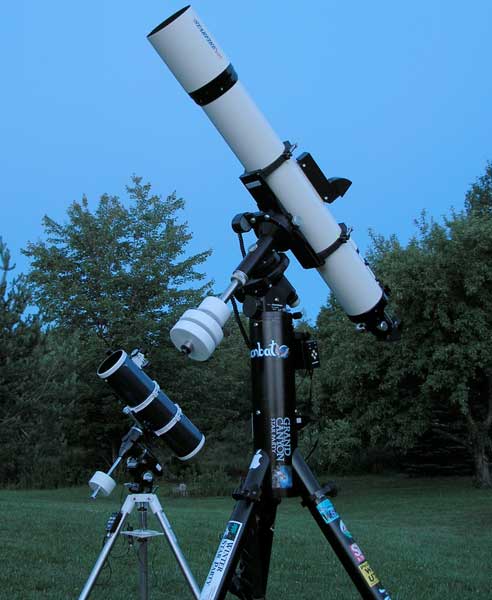
Late on the following
night, which was damp and dewy following the passage of a
storm front, I was out again. Jupiter looked as before,
hinting at potential detail. Diffraction spikes off the big
planet were visible, but not overly obtrusive. The telescope
must have been better cooled, because it did better with
stars. At 214x I got a neat split of the close double Pi
Aquilae (Rebchis), with a separation of about 1.4 seconds of
arc. Deneb at this power appeared pointy and fairly well
defined, and it even star tested better, with no sign of the
zone I thought I saw on the previous night.
The telescope was also
much steadier. Now we come to the primary reason I bought
this telescope: I wanted the tripod. I also have an Orion
Skyview Pro mount, which I use with my Astro-Physics
Stowaway 92mm refractor. It’s an older mount, with an older
tripod, its legs only 1.5” in diameter, and several inches
shorter than the current tripods, even when fully extended.
I knew the newer, taller tripod would make this refractor
more comfortable to use. Therefore I bought the Omni. I
swapped its tripod for my older one, resulting in two hybrid
mounts: a superior blend of the SVP head and the Omni
tripod, and a fusion of the CG-4 head with the old SVP
tripod, which is more in keeping with the petite size of
that mount anyway. The penguin-colored combination of the
nice SVP head with the Omni tripod gave the 150mm reflector
a stable home which pays little heed to raps, taps, and
touches. Clearly, the CG-4 head isn't up to that task, at
least if you approach it as someone used to steady mounts.
The CG-4 will seem luxurious to someone upgrading from a
department store scope.
On the third night
of testing I conducted a “comparo”, specifically one
involving the ancient feud between reflectors and
refractors. Yes, it was 6-inch reflector vs. 6-inch
refractor, going scopo-y-scopo. One
caveat: my big refractor, an Astro-Physics f/9 EDT, is
actually a 155mm, while the Omni is of course a 150.
Therefore the little guy started out with a slight
aperture deficit. I could have evened things out by making
an aperture mask for the refractor, but I was too lazy. I
used only Nagler and Radian eyepieces to make these
comparisons.
When I set these
two scopes up beside each other, I was reminded of
Tolkien’s Middle Earth, with an eager little hobbit
jumping up and down next to a tall Elf Lord while crying
“I can do that! I can do that too!” And you know what? The
cheap little reflector could do most of
what the exalted refractor could do. Most of it...
The first thing I looked
at was the crescent of Venus. Not surprisingly, except for
the diffraction spikes in the Omni, both scopes produced
about the same view. Moving to Saturn, only a degree or so
away, revealed greater differences. At similar powers, the
refractor view was significantly brighter and sharper. No
surprises so far. Jupiter got the most eyepiece time by far.
Using both scopes at around 200x, there was, at first,
little to choose between the two. The views were marred by
high, fast seeing, meaning both scopes looked about the
same, except for the refractor again being brighter.
Contrast was a non-issue. I could not discern much of a
difference between them. I estimate the Omni has a central
obstruction of 25% or more (I’m not going to stick a ruler
down there to find out for sure). That does not appear to be
enough to cause a major reduction in image contrast. I
decided to look at other objects while Jupiter climbed.
One good target was the
unequal double star Delta Cygni. The 155mm EDT is a sublime
splitter of doubles, and this one is no exception, rendered
as a perfect little pair of jewels. Yet the Omni hung right
in there, also producing a neat split, though not quite as
clean as the refractor. I tried a couple of deep-sky
targets, even though the sky was already growing lighter due
to the nearness of moonrise. Here the refractor showed its
superior light grasp, offering sweet views of M13 and the
Ring Nebula which were quite a bit brighter, and a bit
clearer, than those in the Omni. Yet the views in the Omni
were respectable and enjoyable, in the same league, just
somewhat dimmer and not as pristine.
With Jupiter at the
meridian, I returned to it. Now, with the planet barely
above the worst effects of seeing, the 155 EDT pulled ahead,
offering views of Jupiter which were impeccably crisp. The
view in the Omni was softer-edged, but impressively, it
revealed nearly the same detail as the extremely high-end
refractor. The Great Red Spot was making a transit, and was
visible with similar ease in both scopes. I was more
impressed by the similarity of the views than by their
differences. I decided to add a third telescope to the mix,
my 92mm A-P Stowaway refractor, probably the most optically
perfect telescope I own. Its view of Jupiter was much dimmer
than either of the other two scopes, of course, but the
detail revealed was not far behind the Omni. In overall
performance, the $400 Omni was midway between these two
fabled refractors, and closer to the big one than the little
one.
With my mounts spread
thin, I put the Stowaway on the CG-4 for this three-way
shootout. It worked okay, but was distinctly more wiggly
than the SVP. I would prefer to limit the CG-4 to the
smallest scopes, such as an 80mm refractor, a 90mm Maksutov,
or a small solar scope such as the Coronado PST.
I then turned all three
scopes to Izar, Epsilon Bootis. All showed this fairly
close, unequal double beautifully. The Omni was the worst of
the three, but not by any great margin. This time I thought
the view in the Stowaway was best, as its fat, hard Airy
disks displayed the star colors nicely.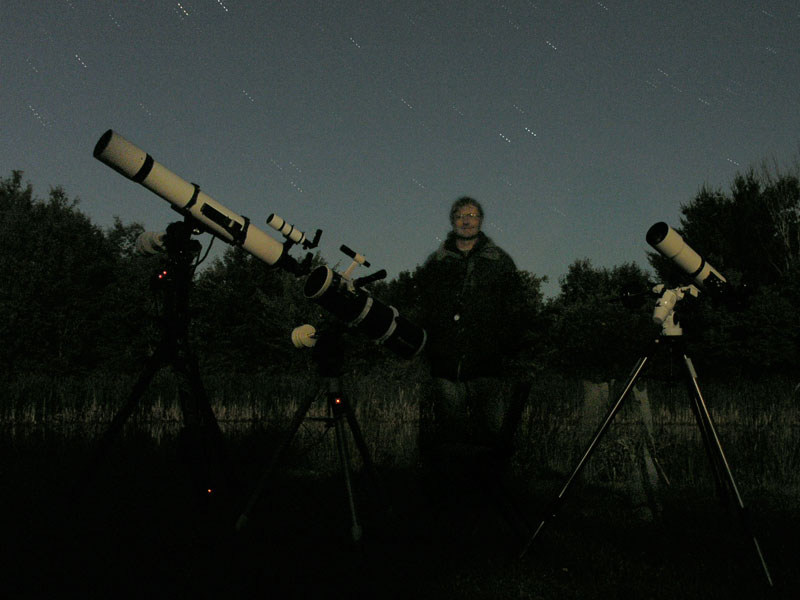

For the fourth and final
night of my test, I used the Omni to view various deep-sky
objects during the brief window between the end of twilight
and the onset of moonrise. At 95x, I had a nice view of M51,
with a suggestion of a swirly pattern. At the same power,
M81 and M82 were two bright lights barely fitting in the
same field of view, two galaxies with very different
personalities. With an OIII filter in place, the Dumbbell
Nebula was big and bright, with traces of wispy detail
across its face. Using Radian eyepieces for 95x and 62x,
stars were sharp across the entire field. The cluster M71 in
Sagitta was a dense, pretty enhancement of the Milky Way
star field. Backing off to 34x with the 22mm Panoptic
eyepiece, the entire Coat Hanger asterism fit into the
field, a pattern of bright, sharp stars.
My pond-side observing spot is hardly a prime dark sky site. I was interested in trying the Omni at a true dark-sky location. My chance came at the 2007 Stellafane convention, where I viewed the following objects, most in Sagittarius:
NGC 6522 and 28: 2 similar small blurs at 94x, separated by about 20'. 22 is about 1 mag brighter and much more concentrated. It has a mag 13 star just NE ofd the core (seen at 150x). 28 is more irregular and shows glimpses of a few very faint stars.
NGC 6540: Small faint elongated irregular spatter of very faint stars. It seems to have a partner, a larger open cluster to the SSE, about 7' away. 94x
NGC 6544: Nice little glob at 150x, elliptical with a few stars resolved.
NGC 6553: Large glob of fairly low surface brightness, not very condensed, a bit flattened, hint of very many faint stars, mag 12 star near NW edge, diameter about 2.5". Nice object.
NGC 6568: At 62x a large, patchy, scattered group, about 15' across, has arcs or incomplete loops, looks like a bird with curved outspread wings. About 30 stars look like members.
NGC 6583: Small ghostly group, very rich, like 7789 but much more distant, and probably obscured by dust.
NGC 6723: Surprisingly bright and easy given it was only about 8 degrees above the horizon. 94x. About 3' diameter. Round, granular, with a few fugitive stars visible.
NGC 6726-27 (CrA) Very near to above. A wide unequal double surrounded by an obvious puff of nebulosity condensed around the stars. A closer, equal pair is about 15' away. 62x.
NGC 6642: Small, faint, round, faint star to the NW, at seen at 64x. At 94x, contains 1 or 2 points. Not a difficult object.
NGC 6638: An easy, small, condensed, neat little thing containing a hint of some coarse sparkles. 94x.
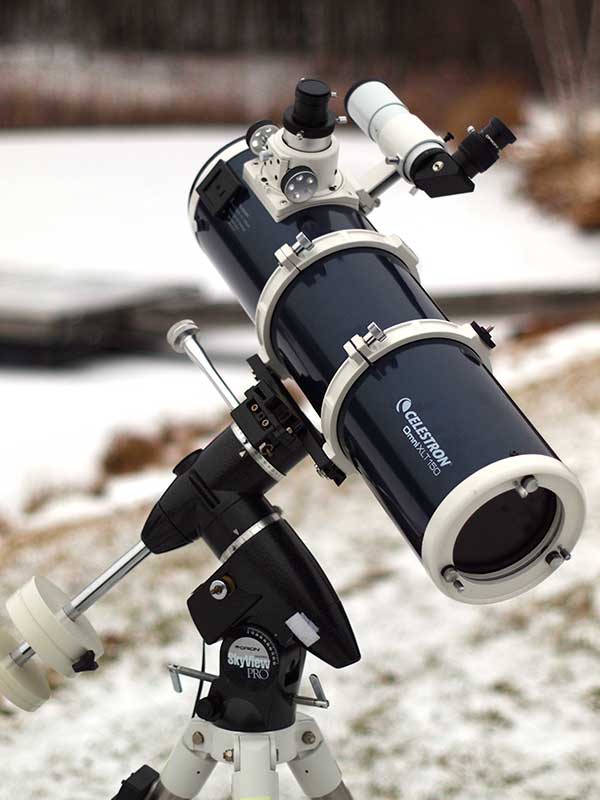
My pond-side observing spot is hardly a prime dark sky site. I was interested in trying the Omni at a true dark-sky location. My chance came at the 2007 Stellafane convention, where I viewed the following objects, most in Sagittarius:
NGC 6522 and 28: 2 similar small blurs at 94x, separated by about 20'. 22 is about 1 mag brighter and much more concentrated. It has a mag 13 star just NE ofd the core (seen at 150x). 28 is more irregular and shows glimpses of a few very faint stars.
NGC 6540: Small faint elongated irregular spatter of very faint stars. It seems to have a partner, a larger open cluster to the SSE, about 7' away. 94x
NGC 6544: Nice little glob at 150x, elliptical with a few stars resolved.
NGC 6553: Large glob of fairly low surface brightness, not very condensed, a bit flattened, hint of very many faint stars, mag 12 star near NW edge, diameter about 2.5". Nice object.
NGC 6568: At 62x a large, patchy, scattered group, about 15' across, has arcs or incomplete loops, looks like a bird with curved outspread wings. About 30 stars look like members.
NGC 6583: Small ghostly group, very rich, like 7789 but much more distant, and probably obscured by dust.
NGC 6723: Surprisingly bright and easy given it was only about 8 degrees above the horizon. 94x. About 3' diameter. Round, granular, with a few fugitive stars visible.
NGC 6726-27 (CrA) Very near to above. A wide unequal double surrounded by an obvious puff of nebulosity condensed around the stars. A closer, equal pair is about 15' away. 62x.
NGC 6642: Small, faint, round, faint star to the NW, at seen at 64x. At 94x, contains 1 or 2 points. Not a difficult object.
NGC 6638: An easy, small, condensed, neat little thing containing a hint of some coarse sparkles. 94x.

The Omni XLT 150 costs
less than 10% of what I paid for the large A-P refractor in
1994, yet it offers about 70% of the visual performance, in
a package that weighs less than half as much. I could
transport and use this scope without giving much thought to
preserving my investment. Today you could pay more for
counterweights and tube rings for a 6-inch apochromat than
the total cost of the Omni. It is a surprisingly serious
stargazing tool for very little money. No observer need be
embarrassed to use such a telescope. A diligent observer
could occupy himself for years with this scope. It would be
fine for a Messier Marathon, and quite feasible for logging
the Herschel 400 from a dark site. It was a lot more
pleasant to use on the stable, driven SVP mount than on the
supplied CG-4, but it’s still useable in its native form.
For my small investment of $338, I not only got
the taller tripod I wanted, but a fine 6” reflector as well,
plus a neat, though limited, little equatorial mount. This
was the third 6” f/5 reflector I’ve owned, so I have a good
idea of what to expect from them. This one gave up nothing
to its two predecessors.
I foolishly sold that original scope for some pittance two or three years after I bought it. Having missed it ever since, I bought a new OTA for a modest price from High Point Scientific at the end of 2014. The newer scope has the advantage of a substantial 2" Crayford focuser, which has me considering it for imaging as well as for eyeballing things.
I foolishly sold that original scope for some pittance two or three years after I bought it. Having missed it ever since, I bought a new OTA for a modest price from High Point Scientific at the end of 2014. The newer scope has the advantage of a substantial 2" Crayford focuser, which has me considering it for imaging as well as for eyeballing things.
Copyright ©2014 by Joe Bergeron
 |
 |
 |
 |
 |
 |
 |